April 6, 2017  Expand to read article below Expand to read article belowThe EZ App Lynx compiler libraries, Android Application, and iOS Application have all been updated to to version 3.0! This version includes three new field types to be used in the app.
The first new addition is the Image field. This allows the app to load images from the web or use some of the already preloaded images in the application bundle. Images loaded from the web are cached on the device so they only need to be downloaded the first time a connection is made. Image fields can be used to display plain images, or the images can be used as buttons. Button images can be one-state or two-state buttons acting similar to the normal button fields. These fields allow two separate images to be loaded, where the first is the "on"/"pressed" state and the second is the "off"/"unpressed" state. If only one image is specified, the image field uses the same image for both states. See EZApp.h and ex_ezapp_images.c included with the current CCS C compiler for more info on how to use the Image fields.
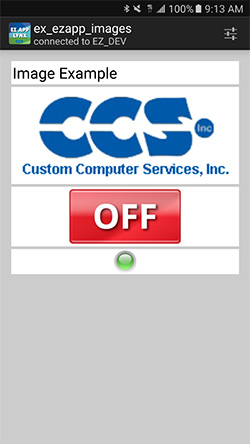
The remaining two new fields are the Graph and Series field types. Together these allow for adding bar graphs and line graphs to the application. The Graph field sets up the graph type, grid lines, labels, data ranges, etc., while the Series field sets up how the data will look on the graph, including color, line type, and series name. Multiple Series fields can be tied to one Graph field, allowing for multiple data sets to be shown on the same graph. See EZApp.h and ex_ezapp_graphing.c included with the current CCS C compiler for more info on how to use the Graph and Series fields.
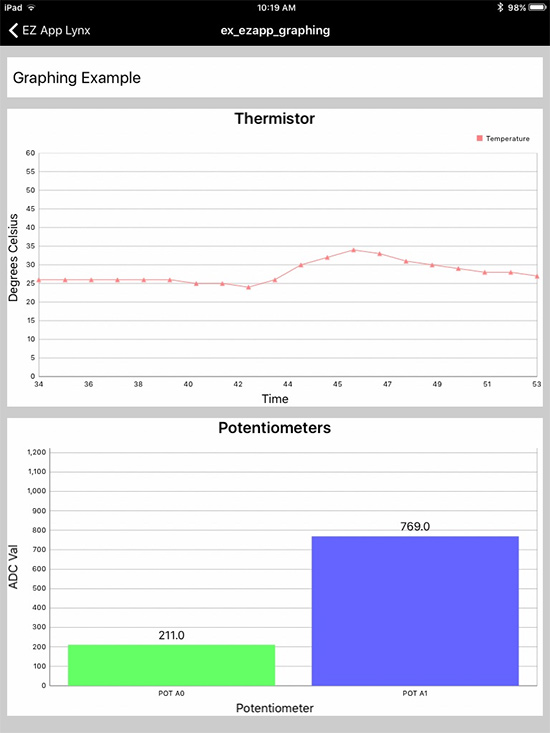
More information about EZ App Lynx, visit: http://www.ccsinfo.com/content.php?page=ez-app
Like us on Facebook. Follow us on Twitter.
About CCS:
CCS is a leading worldwide supplier of embedded software development tools that enable companies to develop premium products based on Microchip PIC ® MCU and dsPIC ® DSC devices. Complete proven tool chains from CCS include a code optimizing C compiler, application specific hardware platforms and software development kits. CCS' products accelerate development of energy saving industrial automation, wireless and wired communication, automotive, medical device and consumer product applications. Established in 1992, CCS is a Microchip Premier 3rd Party Partner. For more information, please visit http://www.ccsinfo.com.
PIC ® MCU, MPLAB ® IDE, MPLAB ® ICD2, MPLAB ® ICD3 and dsPIC ® are registered trademarks of Microchip Technology Inc. in the U.S. and other countries. | April 6, 2017  Expand to read article below Expand to read article belowSerializing devices in a production environment is simple and easy using the CCS C Compiler and the Prime8 Production Programmer. The CCS C Compiler allows for setting up serialization using the #serialize preprocessor directive. A serial number can be saved in binary or as a string, and can be stored in ROM or EEPROM if available.
This example shows a simple way to store a 32-bit binary serial number (4 bytes) in either EEPROM or ROM. The target device has 256 bytes of EEPROM and 32Kbytes of flash program memory, where the serial number is stored in the last 4 bytes of either depending on the defined location. The #ORG in the ROM variant is to reserve the program memory containing the serial number from being used elsewhere by the compiler.
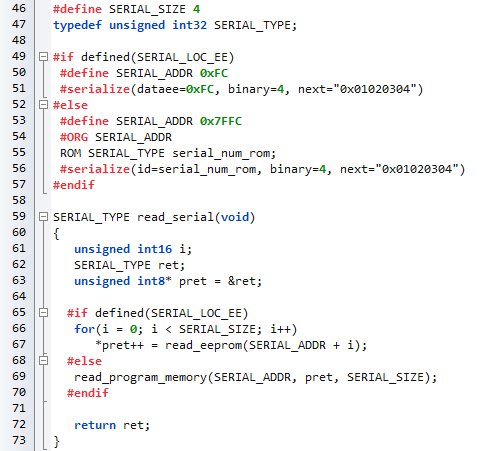
Reading a binary serial number from memory is as simple as reading the raw data directly into a variable using a byte-pointer to that variable. In the example, a pointer is created to a 32-bit variable, which is used to index the raw data bytes. The result is the 32-bit number set by the programmer.
The serialization settings, or "burntime" settings, are saved in the hex file on compilation and are loaded into the Prime8's internal memory when writing the hex file to it. The initial serial number can then be set or changed on the job configuration screen.
Serial numbers are automatically incremented after each successful write, so each connected target will have a different serial number written to it.
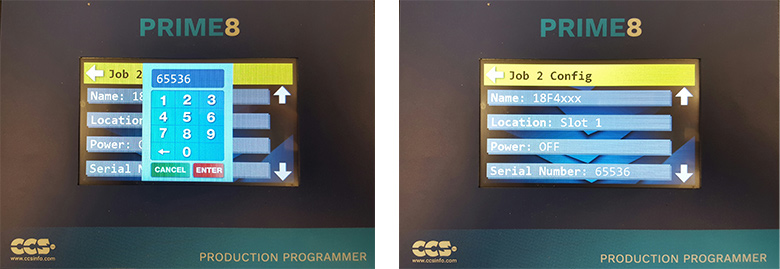
To change the current serial number on the Prime8, select the Config button for the current job. On the Config screen, the file can be selected by touching the "Name/Location" setting, choosing "Internal Memory", and selecting the memory slot the file was written to. This will then show the file name and location on the Config screen. Touch the down arrow until the "Serial Number" setting is visible. Touch this setting to open a keypad where a new serial number can be entered. Once the number is entered, Press the Enter button to save the setting.

Now when the program is written to the targets, the serial number that was entered will be the first serial number written (in this case, 65536), and each successive target will have an incremented serial number (65537, 65538, ...). The number can always be changed or reset by changing the setting again under the job configuration screen.
Prime8 Production Programmer, visit: http://www.ccsinfo.com/product_info.php?products_id=P8_gang
CCS C Compilers, visit: http://www.ccsinfo.com/content.php?page=compilers
Like us on Facebook. Follow us on Twitter.
About CCS:
CCS is a leading worldwide supplier of embedded software development tools that enable companies to develop premium products based on Microchip PIC® MCU and dsPIC® DSC devices. Complete proven tool chains from CCS include a code optimizing C compiler, application specific hardware platforms and software development kits. CCS' products accelerate development of energy saving industrial automation, wireless and wired communication, automotive, medical device and consumer product applications. Established in 1992, CCS is a Microchip Premier 3rd Party Partner. For more information, please visit http://www.ccsinfo.com.
PIC® MCU, MPLAB® IDE, MPLAB® ICD2, MPLAB® ICD3 and dsPIC® are registered trademarks of Microchip Technology Inc. in the U.S. and other countries. | January 11, 2017  Expand to read article below Expand to read article belowCCS has a new software package, Interface Designer, available as part of the IDE compilers. Now users are able to create elaborate Graphical User Interfaces (GUI) with the aid of Interface Designer's user friendly interface. The innovative program eliminates the need to create a GUI entirely from developing C code by allowing users to create a GUI visually within Interface Designer itself.
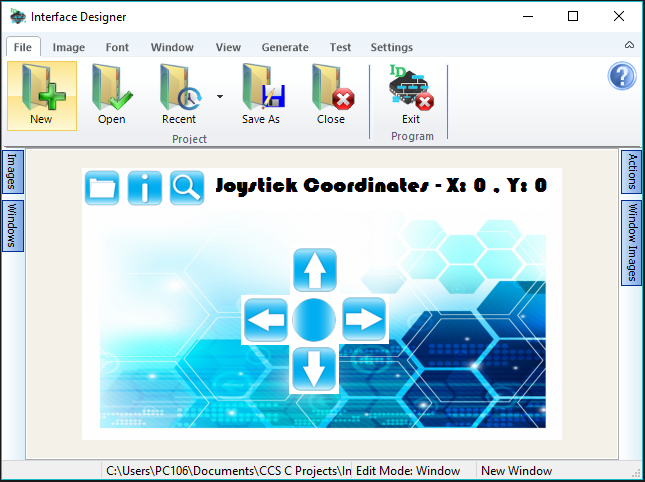
Interface Designer brings user friendly up a notch with its easy to use interface.
- Import custom images or chose from the library of images for use with your GUI.
- Effortlessly create buttons and text boxes with Areas. (A coordinate defined location that registers user touches on the touch screen)
- Implement as many different screens to be used as desired with any amount of Images using Windows, containers that visually display on the touch screen.
- Add Actions allows the defined Area to execute when touched on the touch screen.
- Generate the appropriate C code with one click of a button.
Interface Designer has been designed around the new Touch Display development board developed by CCS. Find the Development Kits or LCD Board here: http://www.ccsinfo.com/product_info.php?products_id=touch-kit
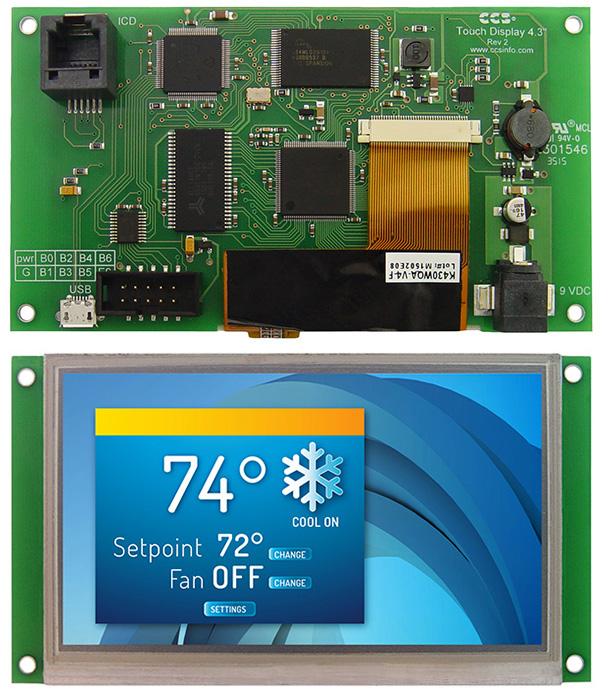
This new development board includes a 4.3" resistive touchscreen with a 480x272 screen resolution and all the hardware necessary to run the most innovative of GUI's. With all the components situated on one development board, the Touch Display gets rid of the typical need to connect a separate microcontroller to an external touch screen display, saving space.
CCS has designed a signature kit for the use of the Touch Display development board which includes all of the necessary hardware and software for successful developing and has included Interface Designer as part of the CCS C Compiler.
Like us on Facebook. Follow us on Twitter.
About CCS:
CCS is a leading worldwide supplier of embedded software development tools that enable companies to develop premium products based on Microchip PIC ® MCU and dsPIC ® DSC devices. Complete proven tool chains from CCS include a code optimizing C compiler, application specific hardware platforms and software development kits. CCS' products accelerate development of energy saving industrial automation, wireless and wired communication, automotive, medical device and consumer product applications. Established in 1992, CCS is a Microchip Premier 3rd Party Partner. For more information, please visit http://www.ccsinfo.com.
PIC ® MCU, MPLAB ® IDE, MPLAB ® ICD2, MPLAB ® ICD3 and dsPIC ® are registered trademarks of Microchip Technology Inc. in the U.S. and other countries. | January 11, 2017  Expand to read article below Expand to read article belowThe Prime8 has gone through a redesign to make it better than before! The Prime8 production programmer is a gang programmer than can program 8 PIC® MCUs simultaneously. It can operate via software control over a USB connection, or it can operate without a PC by storing files inside its memory.
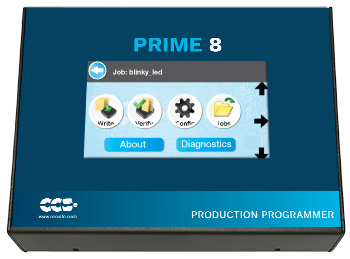
The most impressive update is a touch screen LCD, featuring a much simpler and easy to use user interface. This new UI makes it easy to choose a file and program a file, as well as making it easier to configure the unit. The UI has also been upgraded to show more information about the files stored in its memory.
The speed at which PIC® MCUs can be programmed are also improved. For instance, programming a full PIC24EP256GP206 results in almost 75% reduction in time when using the new Prime8 versus the older models.
The internal memory has been upgraded to 8 megabytes, allowing the user to store eight 1 megabyte files (an improvement over the 2 megabytes and four files of the older models). If a file is larger than 1 megabyte, it can still be stored by using multiple slots of the Prime 8's internal memory. If 8 megabytes of memory isn't enough, it can be expanded using a USB thumb drive connected to the Prime8.
Available Now! Visit: http://www.ccsinfo.com/product_info.php?products_id=P8_gang
Like us on Facebook. Follow us on Twitter.
About CCS:
CCS is a leading worldwide supplier of embedded software development tools that enable companies to develop premium products based on Microchip PIC® MCU and dsPIC® DSC devices. Complete proven tool chains from CCS include a code optimizing C compiler, application specific hardware platforms and software development kits. CCS' products accelerate development of energy saving industrial automation, wireless and wired communication, automotive, medical device and consumer product applications. Established in 1992, CCS is a Microchip Premier 3rd Party Partner. For more information, please visit http://www.ccsinfo.com.
PIC® MCU, MPLAB® IDE, MPLAB® ICD2, MPLAB® ICD3 and dsPIC® are registered trademarks of Microchip Technology Inc. in the U.S. and other countries. | December 6, 2016  Expand to read article below Expand to read article belowThe Signal Measurement Timer (SMT) is a powerful new timing peripheral found on several of the newer PIC® MCU devices, such as the PIC16F18877 and PIC18F67K40 families. Each SMT is a 24bit timer that can operate in one of several modes:
* Timer - A simple 24bit timer, similar to the Timer0 or Timer1 peripheral.
* Gated Timer - Like timer mode above, but only increments when the signal GPIO signal is high.
* Period and duty cycle measurement - Like gated timer, increments a counter when the signal GPIO signal is high. But when the signal GPIO goes low, the timer value is stored for future use and the counter is reset back to 0.
* High and low measurement - Similar to Period and duty cycle mode above, but resets and stores on every signal edge.
* Window Measurement - akin to period and duty cycle measurement above, but measures time between two rising edge signals on the window GPIO pin.
* Gated window measurement - Like window measurement above, but time only increments when the signal GPIO pin is high.
* Time of flight - Similar to window measurement, but timing starts when the window GPIO pin goes high and the timer is stored and reset to 0 when the window GPIO pin or signal GPIO pin goes high.
* 24bit capture - Simply stores the timer value when the window GPIO pin changes state.
* 24bit counter - Counts all the rising edges of the signal GPIO pin.
* Gated counter - Comparable to the 24bit counter mode, but only increments when the window GPIO pin is high.
* Windows counter - Like the gated counter mode, but a rising edge of the window GPIO pin will store the existing timer counter and then reset it to 0.
The CCS C Compiler has been updated to add a library that allows for controlling, configuring and using the SMT in your PICmicro C projects. The functions that have been added are setup_smtX() (or setup_smt1() to setup the first SMT peripheral), smtX_status(), smtX_start(), smtX_stop(), smtX_update(), smtX_reset_timer(), smtX_read() and smtX_write(). For more help, refer to the CCS C Compiler Help file for documentation.
Here is an example of using the Timer mode to blink an LED at a 1Hz rate:
#define LED_PIN PIN_B4
#define SMT_PERIOD (getenv("CLOCK") - 1)
#INT_SMT1
void my_smt_isr(void)
{
output_toggle(LED_PIN); }
void my_smt_init(void)
{
setup_smt1(SMT_ENABLED | SMT_MODE_TIMER | SMT_CLK_FOSC, SMT_PERIOD);
smt1_start();
enable_interrupts(INT_SMT1);
enable_interrupts(GLOBAL); }
The CCS C Compiler also provides 2 full example programs showing how to use the SMT, which can be found in the examples directory of the CCS C Compiler. First ex_smt_timer.c which is an example of using the SMT peripheral in Timer mode to toggle an I/O pin, and second ex_smt_period_duty.c which is an example of using the SMT peripheral in Period and Duty Cycle Acquisition mode to determine the period and duty cycle of an input signal.
Like us on Facebook. Follow us on Twitter.
About CCS:
CCS is a leading worldwide supplier of embedded software development tools that enable companies to develop premium products based on Microchip PIC ® MCU and dsPIC ® DSC devices. Complete proven tool chains from CCS include a code optimizing C compiler, application specific hardware platforms and software development kits. CCS' products accelerate development of energy saving industrial automation, wireless and wired communication, automotive, medical device and consumer product applications. Established in 1992, CCS is a Microchip Premier 3rd Party Partner. For more information, please visit http://www.ccsinfo.com.
PIC ® MCU, MPLAB ® IDE, MPLAB ® ICD2, MPLAB ® ICD3 and dsPIC ® are registered trademarks of Microchip Technology Inc. in the U.S. and other countries. | December 6, 2016  Expand to read article below Expand to read article belowThe Capture Compare (CCP) peripheral of the PIC16 and PIC18 PIC® MCUs and the Input Capture (IC) peripheral of the dsPIC and PIC24 PIC® MCUs allow the MCU to capture and hold a timer value when a specific input pin reaches a user defined state. This peripheral is useful for measuring the duration between events, or determining the frequency or duty cycle of an incoming signal. This peripheral operates independent of the MCU operation, meaning it can trap the timer on the input signal without the developer having to block code execution waiting for the input signal to happen.
Version 5 of the CCS C Compiler has added a #use capture() library that makes it easy to use the CCP or IC peripheral. The API for this library provides an easy to use method for using and configuring the peripheral and timers, while also being portable from one PIC® MCU device to another. Here is an example of its use:
#use capture(CCP1, input=PIN_C2, capture_rising, stream=CAPTURE1)
unsigned int16 WaitForEvent(void)
{
while(!get_capture_event(CAPTURE1));
return(get_capture_time(CAPTURE1)); }
#use capture() configures a CCP or IC peripheral for use, and by using the STREAM option several peripherals can be configured with several instances of #use capture(). #use capture() also provides a method of configuring the timer peripheral to use and the tick rate of the timer. Several other configuration options exist, see the compiler help manual for documentation.
get_capture_event() returns TRUE if the CCP or IC peripheral has trapped an event that can be read, and get_capture_time() returns the time the event happened.
The CCS C Compiler provides an example of using this library, ex_use_caputure.c which can be found in the examples directory of the CCS C Compiler. This example can be used on any PCM, PCH or PCD version 5 CCS C Compiler.
Like us on Facebook. Follow us on Twitter.
About CCS:
CCS is a leading worldwide supplier of embedded software development tools that enable companies to develop premium products based on Microchip PIC ® MCU and dsPIC ® DSC devices. Complete proven tool chains from CCS include a code optimizing C compiler, application specific hardware platforms and software development kits. CCS' products accelerate development of energy saving industrial automation, wireless and wired communication, automotive, medical device and consumer product applications. Established in 1992, CCS is a Microchip Premier 3rd Party Partner. For more information, please visit http://www.ccsinfo.com.
PIC ® MCU, MPLAB ® IDE, MPLAB ® ICD2, MPLAB ® ICD3 and dsPIC ® are registered trademarks of Microchip Technology Inc. in the U.S. and other countries. | October 14, 2016  Expand to read article below Expand to read article below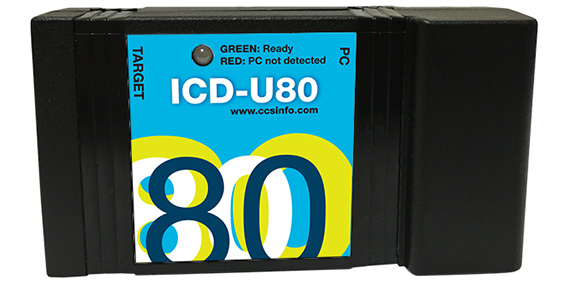 Sku: 53506-1648 Price: $119
Introducing the new ICD-U80 Programmer/Debugger from CCS. The advantages of the ICD-U80 include:
- Accelerated programming speed
- Integrated Vdd generator to supply 1.5-5.5V to target
- Software controlled power to target - no jumpers to change
Check out the complete line of CCS Programmer/Debuggers to fit your needs. http://www.ccsinfo.com/programmers-debuggers.php
Like us on Facebook. Follow us on Twitter.
About CCS:
CCS is a leading worldwide supplier of embedded software development tools that enable companies to develop premium products based on Microchip PIC ® MCU and dsPIC ® DSC devices. Complete proven tool chains from CCS include a code optimizing C compiler, application specific hardware platforms and software development kits. CCS' products accelerate development of energy saving industrial automation, wireless and wired communication, automotive, medical device and consumer product applications. Established in 1992, CCS is a Microchip Premier 3rd Party Partner. For more information, please visit http://www.ccsinfo.com.
PIC ® MCU, MPLAB ® IDE, MPLAB ® ICD2, MPLAB ® ICD3 and dsPIC ® are registered trademarks of Microchip Technology Inc. in the U.S. and other countries. | June 7, 2016  Expand to read article below Expand to read article belowLooking to store settings or data in your embedded project, but you are using a PIC® MCU without an internal EEPROM and your design doesn't have an external EEPROM? The virtual EEPROM driver included in the CCS C Compiler adds the ability to use the PIC® MCU's re-programmable flash memory as data storage. This driver also performs write balancing, which allows the developer to write to a specific location several times without fear of wearing out the endurance of the flash memory. The virtual EEPROM driver recently was updated to add support for PIC16 and to optimize the memory usage when used on 8-bit PIC® MCUs (PIC16, PIC18, etc).
To add this library into your project, simply #include the file virtual_eeprom.c. The function init_virtual_eeprom() needs to be called to initialize access to the virtual EEPROM. write_virtual_eeprom() can be used to write a value to a location, and read_virtual_eeprom() can be used to read the value at a specified location. The last two erase pages of the PIC's re-programmable flash are used as storage for the virtual EEPROM system.
Here is an example of usage:
#include <virtual_eeprom.c>
void test_virtual_eeprom(void)
{
init_virtual_eeprom();
write_virtual_eeprom(0, 55);
write_virtual_eeprom(1, 65);
write_virtual_eeprom(2, 75);
printf("%urn", read_virtual_eeprom(0)); //should say '55'
printf("%urn", read_virtual_eeprom(1)); //should say '65'
printf("%urn", read_virtual_eeprom(2)); //should say '75' }
Like us on Facebook. Follow us on Twitter.
About CCS:
CCS is a leading worldwide supplier of embedded software development tools that enable companies to develop premium products based on Microchip PIC ® MCU and dsPIC ® DSC devices. Complete proven tool chains from CCS include a code optimizing C compiler, application specific hardware platforms and software development kits. CCS' products accelerate development of energy saving industrial automation, wireless and wired communication, automotive, medical device and consumer product applications. Established in 1992, CCS is a Microchip Premier 3rd Party Partner. For more information, please visit http://www.ccsinfo.com.
PIC ® MCU, MPLAB ® IDE, MPLAB ® ICD2, MPLAB ® ICD3 and dsPIC ® are registered trademarks of Microchip Technology Inc. in the U.S. and other countries. | June 7, 2016  Expand to read article below Expand to read article belowSupport has been added to the CCS C Compiler for the new Analog-To-Digital Converter with Computation (ADC2) module that the PIC16F188xx family of devices have. In addition to legacy mode of operation the ADC2 module can be setup in Accumulate, Average, Burst Average or Low-Pass Filter modes of operation. When setup for Accumulate mode with each trigger of the ADC the conversion result is added to the accumulator and the ADCNT register is incremented. When setup for Average mode with each trigger of the ADC the conversion result is added to the accumulator and when the specified number of triggers has been done the average will be preformed on the accumulator. When setup for Burst Average mode it is similar to Average mode the difference being that when the ADC is triggered, it will perform the specified number of conversions and then perform the average calculation. When setup for Low-Pass Filter mode with each trigger of the ADC the conversion result is sent through the filter.
To support the new modes of operation the CCS C Compiler's built-in setup_adc() function has been updated to setup the ADC in these modes. Additionally an optional second and third parameter as been added to the function to set some additionally settings when using these the new modes of operation. When using Accumulate, Average or Burst Average modes the second parameter sets how much the accumulated value is divided by after each conversion. When using Low-Pass Filter mode the second parameter sets the cut-off frequency of the filter. The third parameter to the function sets the number of samples to be done before performing a threshold comparison for Average, Burst Average and Low-Pass Filter modes of operation.
In addition to the updates to the setup_adc() function the built-in functions adc_write() and adc_read() have been added to write and read some the other registers used by the ADC2 module. For example when setup for Low-Pass Filter mode the filtered result is stored in the ADFLTRH and ADFLTRL registers. After the calculation is completed the adc_read() function can be then be used to read the filtered result, for example:
Result = adc_read(ADC_FILTER);
Another feature of the ADC2 module is the ability to set a trigger source to start a conversion. To support this feature the built-in function set_adc_trigger() has been added to the CCS C Compiler. For example the following can be used to setup the ADC2 module to trigger the conversion when Timer 2 period match occurs:
set_adc_trigger(ADC_TRIGGER_TIMER2);
The following is an example using the CCS C Compiler to setup and use the ADC2 module for Low-Pass Filter mode, see ex_lowpass_filter_adc2.c in the PICCExamples folder for entire example:
setup_timer_2(T2_CLK_INTERNAL | T2_DIV_BY_128, 155, 10); //~10ms period, 100ms interrupt
setup_adc_ports(ADC_PIN, VSS_VDD);
setup_adc(ADC_LOW_PASS_FILTER_MODE | ADC_CLOCK_INTERNAL | ADC_TAD_MUL_255 | ADC_THRESHOLD_INT_END_OF_CALCULATION, FILTER_CUT_OFF_FREQ, ADC_READINGS);
set_adc_channel(ADC_CHANNEL);
set_adc_trigger(ADC_TRIGGER_TIMER2);
while(TRUE)
{
if(interrupt_active(INT_AD_THRESHOLD))
{
FilteredResult= adc_read(ADC_FILTER);
clear_interrupt(INT_AD_THRESHOLD); } }
Like us on Facebook. Follow us on Twitter.
About CCS:
CCS is a leading worldwide supplier of embedded software development tools that enable companies to develop premium products based on Microchip PIC ® MCU and dsPIC ® DSC devices. Complete proven tool chains from CCS include a code optimizing C compiler, application specific hardware platforms and software development kits. CCS' products accelerate development of energy saving industrial automation, wireless and wired communication, automotive, medical device and consumer product applications. Established in 1992, CCS is a Microchip Premier 3rd Party Partner. For more information, please visit http://www.ccsinfo.com.
PIC ® MCU, MPLAB ® IDE, MPLAB ® ICD2, MPLAB ® ICD3 and dsPIC ® are registered trademarks of Microchip Technology Inc. in the U.S. and other countries. | March 14, 2016  Expand to read article below Expand to read article belowNow available are two new development boards from CCS, the Rapid-18 and LPC Starter. CCS also has updated the PIC24 development boards to now include the PIC24FJ256GA106 and the PIC24EP256GP206.
The Rapid-18 uses the PIC18F4523 and has a built-in bootloader for loading code and a USB port for text communication to the running program, and provides advanced peripherals including a 12-bit ADC. The prototyping board features a PIC18F4523 attached to a potentiometer, two pushbuttons, three LEDs, and an ICD connector.
LPC Starter is designed to be an easy way to start software testing with the low pin count (8, 14, 18 and 20) parts that are not as easy to find on other development boards. This board provides standard IC sockets for DIP parts, access to all I/O pins, three LEDs, two buttons, one potentiometer, and a USB to RS-232 converter. Dip switches are used to connect or disconnect the USB port and to select internal or external (8Mhz) clock for the 14, 18 and 20 pin sockets.
CCS has also updated the devices to newer PIC24 devices for general development. The PIC24F board has the newer PIC24F256GA106 device that includes access to 53 I/O pins. The PIC24EP board has the PIC24EP256GP206 that includes 53 I/O pins, 16 analog pins and 2 RS-232 ports.
Click here to view all CCS Development Kits: http://www.ccsinfo.com/development-kits.php
Like us on Facebook. Follow us on Twitter.
About CCS:
CCS is a leading worldwide supplier of embedded software development tools that enable companies to develop premium products based on Microchip PIC® MCU and dsPIC® DSC devices. Complete proven tool chains from CCS include a code optimizing C compiler, application specific hardware platforms and software development kits. CCS' products accelerate development of energy saving industrial automation, wireless and wired communication, automotive, medical device and consumer product applications. Established in 1992, CCS is a Microchip Premier 3rd Party Partner. For more information, please visit http://www.ccsinfo.com.
PIC® MCU, MPLAB® IDE, MPLAB® ICD2, MPLAB® ICD3 and dsPIC® are registered trademarks of Microchip Technology Inc. in the U.S. and other countries. |
|
